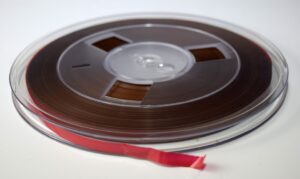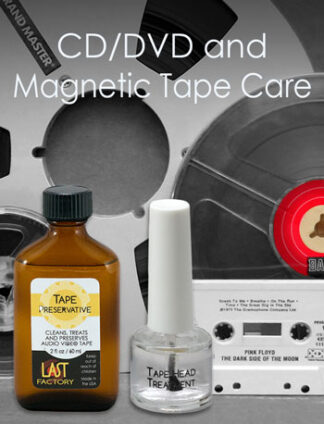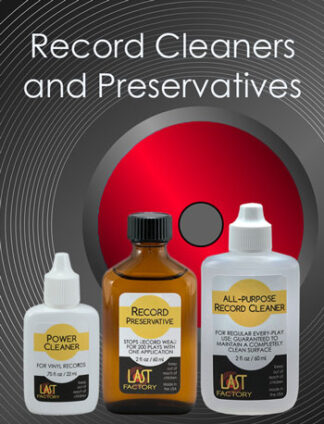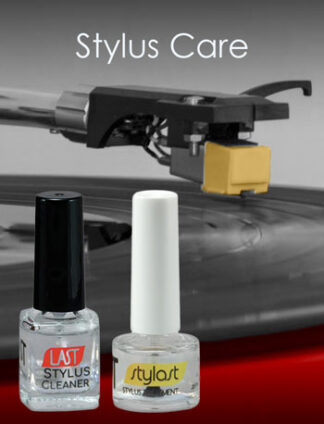Preserving Magnetic Tape
by Walter E. Davies, Director of Research for The LAST Factory, Livermore CA
Broadcast Engineering, October 1987
The sound of the world are preserved on magnetic tape.
They can be kept alive for only as long as the tape lasts.
 Magnetic tape has been entrusted to preserve a precious commodity, a heritage. Virtually all of the acoustical information in the world is on flexible magnetic media, which has a maximum lifetime measured in decades. Much is known about the factors that affect tape longevity. This article considers some of the more important ones. Researchers at the National Bureau of Standards estimate that current magnetic tapes have a useful lifetime of approximately 20 years at ambient conditions 1 Reading failures during accelerated life testing appear to be caused primarily by loss of material from the binder layer. It is worthwhile to explore the physical and chemical parameters that cause degradation of flexible magnetic media, and the environmental factors that will provide the longest useful lifetime for it.
Magnetic tape has been entrusted to preserve a precious commodity, a heritage. Virtually all of the acoustical information in the world is on flexible magnetic media, which has a maximum lifetime measured in decades. Much is known about the factors that affect tape longevity. This article considers some of the more important ones. Researchers at the National Bureau of Standards estimate that current magnetic tapes have a useful lifetime of approximately 20 years at ambient conditions 1 Reading failures during accelerated life testing appear to be caused primarily by loss of material from the binder layer. It is worthwhile to explore the physical and chemical parameters that cause degradation of flexible magnetic media, and the environmental factors that will provide the longest useful lifetime for it.
The Cast of Materials
Magnetic tape consists of a magnetically active coating on a flexible thin-film substrate of polyethylene terephthalate (PET). The stability of PET film is such that it retains its useful properties for hundreds of years at normal temperature and humidity (20o C and 50% relative humidity RH).2
The information-storing layer can contain oxide compounds of iron, cobalt, and sometimes chromium. Some newer formulations contain metal particles rather than metal-oxide particles. The ferromagnetic particles are suspended in a binder that holds them to the film backing. The binder is a technical wizard’s brew containing components that serve as lubricants, adhesives, dispersants, anti-static agents and stabilizers. The principal binder component usually is cross-linked polyester polyurethane, but polyvinyl chloride (PVC) and polyacrylonitrile also are used.
Tape life is determined by the physical stability of the base film and the chemical stability of the oxide coating. These factors are controlled to a great extent by the environmental conditions of temperature, humidity and cleanliness.
Base Film Stability
The coefficient of expansion for temperature and humidity are relatively uniform for all polyester-based magnetic tapes. For temperatures from 50o F to 110oF:
KT = 1.5 X 10-5 in/in/Fo
For relative humidity from 20% to 90%:
KH = 1.1 X 10-5 in/in/ %RH
The following example shows how these coefficients relate to this discussion. Take a tape that has been in use in a hot, muggy (95o F 90% RH) on-location recording situation. Now place that tape in a cold, dry (50oF, 40% RH) tape-storage locker. The tape, when it reaches equilibrium, will attempt to shrink by almost 6 feet in length. The pressure loading on the hub and inner layers of tape is crushing.
Humidity and Headwear
The most important factor (in terms of headwear) is environmental conditions rather than the physical characteristics of tape. The head-to-tape interface is particularly sensitive to environmental humidity, and wear may be five to 10 times greater at 90%HR than at 40%RH. 3
Air-filtering procedures also are critical, because air pollution, such as dust and smoke, can double the headwear rate. Therefore, humidity control and air-cleaning procedures (as well as a ban on smoking and eating) should be instituted in tape workrooms and storage areas.
Storage Environments
Large swings in either temperature or humidity is detrimental to the life of stored tape. Rapid changes in temperature or humidity place enormous stress on a tape pack. If tape is stored under one set of environmental conditions and used in another, it should be allowed a period of time to condition (reach equilibrium to the new environment).
Although changes in a tape’s environment can be damaging, it is the cycling back and forth over temperature and humidity gradients that is most destructive to a tape. Given the choice, the tape user, the librarian or the archivist should store tapes in a relatively constant environment that is not subject to dramatic and rapid temperature or humidity swings.
Manufacturers recommend that tape storage be dust-free. 4 The tape should be on flanged reels for long-term support and should be placed in well-sealed polyethylene bags. The function of the bags is to prevent lubricant evaporation and to act as a hermetic seal to reduce binder degradation. The bagged tape should be boxed and stored in a vertical position on the shelf. A reasonable storage environment could be considered the range of 50oF to 75o F with a humidity ranger of 30% to 45% RH.
Tape Binder Degradation
The physical effects of environmental temperature and humidity act primarily on the film base that carries the magnetically sensitive layer. The degradation of the binder, which contains the magnetic particle suspension, is principally a chemical process.
It was stated previously that most magnetic recording tape uses a cross-linked polyester polyurethane binder. A polyester is a chain of ester compounds. Esters are formed as a result of chemical reactions between acids and alcohols. This reaction releases water as a by-product.
Tape in the presence of atmospheric moisture is subject to hydrolysis. In this reaction, water combines with an ester to form carbolic acid and alcohol. Because the ester is part of the linking that holds together the binder, hydrolysis weakens the binder and results in the shedding of the oxide layer, in dropouts and the eventual loss of the tape (and its information) through severs degradation.
The good news is that hydrolysis is reversible and need not occur under proper storage conditions. Because hydrolysis is a chemical reaction, the rate of the reaction depends upon the concentration. And, like most chemical reactions, it is temperature-dependent; that is, it varies directly with temperature.
So where does all this lead? And environmental safety zone exists for the use and storage of magnetic tape. Certain combinations of temperature and humidity are only marginally safe. Finally, under some conditions, hydrolysis proceeds to a point that tape binder cannot be used or stored safely. The graph in figure 1 illustrates the range of environments safe for tape use and storage. 5
The Range of Tape Defects
Six major types of tape defects exist, each with a probable cause. Some allow recovery, while others do not.6 The six problems are:
- Oxide pullout. Recovery is impossible. The usual cause is hydrolysis.
- Permanent errors. Plastic cold flow from non-uniform and excessive stress builds up in the tape when it is subjected to changes in temperature and humidity. These environmental changes cause different rates of expansion in the length and thickness of the tape, producing stresses that permanently deform the tape.
- Surface contamination and dimples. Usually, dirt wrapped into a reel eventually will create dimples in adjacent layers of tape. Recovery is probable through cleaning and multiple passes on the machine used to reproduce the recorded information.
- Creases and scratches. Creases usually are cause by poor wrap in the tape pack. These are aggravated by poor handling and undesirable environmental conditions. Recovery is possible if you follow the procedure recommended in item 3.
- Torn tape in the middle of the pack. This is a sure sign that the tape was subjected to temperature and humidity extremes, either in storage or transit.
- Adhesion and blocking. Adhesion of adjacent tape layers is caused by static build-up on tape surfaces and storage of tapes in extremely dry conditions. Excessively low humidity may be by design (a mistake) or because a humidifier is not being used in conjunction with air-conditioning. Blocking has no recovery procedure. Excessive humidity and temperature will cause the inner 1/2″ of a tape pack to become a solid mass of base and binder. It can be prevented only by proper environmental controls.
Long-Term Stability
It is possible to increase the long-term stability of tape, but can anything be done to tape that has approached the 20% hydrolysis level? Polymer chemists in the tape industry have developed preservatives that address these and other questions.
The prime considerations are effectiveness, safety, compatibility and stability. A concomitant characteristic of importance to users is the capability to apply preservative to existing magnetic media.
A preservative must act as a buffer to slow the process of hydrolysis. If it can increase the size of the safety window, so much the better (see Figure 1). It must present no safety hazard in its use or application. A preservative must be non-toxic., non-carcinogenic, non-flammable and non-injurious to personnel and tape.
The problem of compatibility is substantial. A preservative must be fully compatible with the various magnetic sensitive materials as well as with all the components in the binder matrix. Finally, this magic bullet must maintain its stability and remain effective and safe and compatible for decades.
Testing
Tests by numerous organizations have demonstrated a high level of satisfaction with a chemical family that has met these requirements and solved other tape wear problems.
A member of this family has been used for several years as a preservation component, in small quantities in binder applications. Because the preservative and the surface lubricant are molecularly (rather than chemically) bound in the binder matrix, a search was initiated to locate a different family member that would combine the functions of lubricant and preservative. The search has come to fruition with the development of such a component. Furthermore, the material may be applied after market, in the field. This means that its benefits are available for tape currently in use and in storage.
The preservative’s effectiveness has been demonstrated through accelerated wear-tests by several test agencies. In comparing identical tapes, half of which were treated with the preservative, it was shown that abrasion of the treated tapes was cut in half, the coefficient of friction was reduced by one-third, and the life of the tape was extended by three to seven times, depending upon the type of oxide.
The preservative easily meets safety standards and is completely non-hazardous in use or application. It will not degrade under storage or use conditions for magnetic tape, and it is so stable that its lifetime approaches that of the PET base material.
To assure compatibility, the search was restricted to recognized, current product groups used in this application. In addition, tests have determined compatibility with all of the materials with which tape would come into contact during normal use. Heads, guides, rollers and capstan-drive components, as well as the many plastics that make up housings, all have been tested successfully.
Preliminary findings point to performance benefits as well. The improved interface between head and tape has resulted in increases in signal-to-noise ratios, improvements in high-frequency response and decreases in distortion levels. These results have strong implications in the analog recording domain.
Current testing involves the factors of coercivity, retentivity, print-through and ongoing life. Experiments will continue as the industry pursues the goal of preserving its acoustic and video heritage.
Bibliography
(1) Brown, D.W., R.E. Lowry and L.E. Smith. “Prediction of the Long Term Stability of Polyester-based Recording Media.” National Bureau of Standards, NBS1R 86-3474 June 1986.
(2) Ibid.
(3) Sargent, R.N. “Preserving the Moving Image.” Corporation for Public Broadcasting, 1974.
(4) Bertram, N. and A. Eschel. “Recording Media Archival Attributes (Magnetic).” Ampex Corporation, Report F 30602-78-6-0181, 1979.
(5) Ibid.
(6) Rosenkrantz, G. “Handbook of recommended Environmental Conditions and Handling Procedures for Magnetic Tape.” National Archives and Records Service, Data Archives Branch, Washington, DC.





